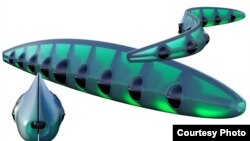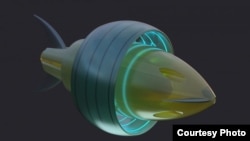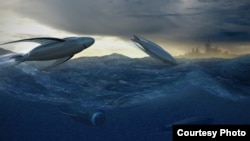New images released by Britain’s Royal Navy show how future submarines could look and move like real sea creatures.
The designs were created by young British engineers and scientists. They were challenged by the Royal Navy to imagine how future underwater war machines might look.
The engineers and scientists are members of the group UKNEST. This not-for-profit organization promotes science, engineering and technology for British naval design.
The group kept the same requirements used in advanced submarines used today. But the designers added new technological ideas to make them easier and less costly to build, as well as more effective in battle.
Current submarines were designed to perform many roles as a single piece of equipment. But the Royal Navy of the future is expected to operate a family of submarines. This would include many shapes and sizes to carry out different operations. Some submarines would be manned and others unmanned.
The designs included a “mothership” that would act as a major command and control center supporting other submarines and ships. This submarine, with a crew of about 20 people, would be shaped like a manta ray with wide wings to guide it through the sea. The futuristic mothership would travel to British-controlled waters worldwide, docking with other underwater bases.
The future Royal Navy might also use eel-like unmanned underwater vehicles. The designers imagined these submarines as capable of curving around objects like an eel and disguising themselves as sea lifeforms. They could be launched from the mothership and travel hundreds of miles in near silence.
Some of the naval equipment would be engineered with materials to dissolve after a period of time to avoid being captured by enemies. One image even shows flying missile weapons shooting out of the water like sharks or dolphins.
The submarine design project was called Nautilus 100. It was named after the U.S. Navy’s USS Nautilus, the world's first nuclear-powered submarine.
Britain’s Minister for Defense Procurement, Harriet Baldwin, praised the project. “These remarkable designs display the great promise of our young engineers and scientists and the great ambition of the Royal Navy.”
She added that the futuristic concepts are an example of what Britain’s navy could produce to meet future military challenges.
Commander Peter Pipkin is a robotics officer with the Royal Navy. He said that with more than 70 percent of the planet covered by water, there will be more competition between nations in the future to live and work at or under the sea. For this reason, he said the Royal Navy is looking 50 years into the future to find new ways to protect British interests around the world.
“If only 10 percent of these ideas become reality, it will put us at the cutting edge of future warfare and defense operations," Pipkin said.
I’m Bryan Lynn.
Bryan Lynn wrote this story based on information from the Royal Navy website. Hai Do was the editor.
We want to hear from you. Write to us in the Comments section, and visit our Facebook page.
_____________________________________________________________
Words in This Story
challenge – v. invite a person to compete in a contest or fight
dock – v. join together with another ship
disguise – v. change the appearance of something so it cannot be recognized
dissolve – v. break down or disappear
ambition – n. goal or aim to do or be something
concept – n. an idea of what something could be












